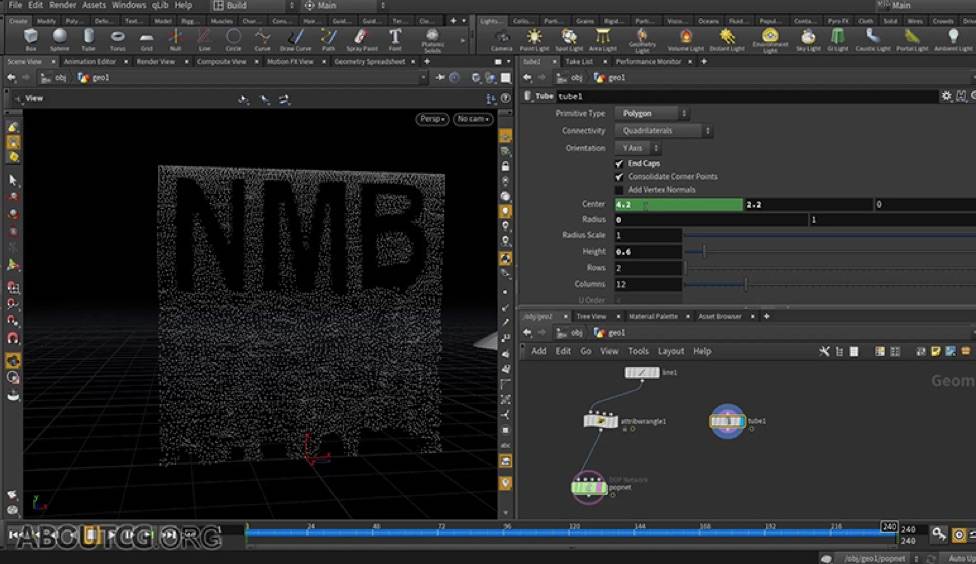


Some VOPs are actually a collapsed network of many VOPs with particular parameters promoted to the top level. Just LMB on stucco's P input and then LMB again in a blank area anywhere in the network editor.

Say you had a P from the Global Variable VOP wired into P on the stucco node and you wanted to disconnect it. To wire the color output to some other input, LMB on color and then on the desired input. Connecting inputs and outputs works just like in other contexts. You can collapse the display of the node to varying degrees by selecting the 1, 2 or 3 dots to the right of the icon. Just as in other contexts, you can LMB the icon in the upper-left to drag the node around the network editor pane or MMB to get an popup info window. The Output VOP only has inputs, because this node is the last node in a VOP network and all information computed in a VOPnet must pass its results out through the Output node. This is because you are bringing information from geometry into VOPs for use. There are some VOPs, like the Global Variables VOP, that only have inputs even though they are located on the right of the node. So, the Stucco VOP has eight inputs and one output. Most VOPs have inputs on the left and outputs on the right. One example of a VOP, being a Stucco VOP, is shown in Figure 1. As you continue through your journey in Houdini, you come to have more and more contact with each of these languages. When you create a new COP in VEX you are modifying pixels. When you create a new CHOP in VEX, you are modifying channel data. When you create a new SOP or POP with VEX, you are modifying attributes of the geometry's points, like color or position. When you create a surface shader in VEX (or VOPs, because VOPs are really just a GUI for VEX), you are modifying attributes on the surface of the object being rendered. VEX is a very specialized programming language that does one thing, and does it extremely quickly: It modifies attributes. You can also use expressions with Hscript, to create more complex scripts. Expressions are often used directly in an operator's parameters to create channel references, animate a channel like using a sin() expression, and more. You can add new operators, wire them together, change their parameters and many other things with Hscript. Hscript gives you commands to directly control Houdini and its user interface. In fact, Hscript and Expressions are very closely related and can work together. There are at least three "scripting" languages in Houdini: Hscript, Expressions, and VEX. In a sea shell, VOPs are an extremely powerful context where your options and are both far and wide. VOPs can be used to make parts of a lighting system, designed so a new user just wires up the pieces and doesn't worry about the details. The VEX Mountain SOP was created using VEX, so you can create your own version in VOPs if you wanted to. For example, the Sprinkler POP was created using VEX, which means it can be created using VOPs. VOPs let you create new COPs, so you can use them to create cool compositing operations. VOPs let you create new POPs, so you can use them to create effects. VOPs let you create new CHOPs, so you can use them as an animation tool. VOPs let you create new SOPs, so you can use them as a modeling tool. You can use VOPs to create very simple, specific shaders or you can create very complex, general shaders and anywhere in between. However, if you don't know VEX, that's fine too! VOPs were designed to be useful to all levels of users. If you already know VEX, you'll find VOPs a quicker way to create VEX code. You can graphically wire together nodes, which essentially creates blocks of VEX code. Each VOP node contains a snippet of VEX code. VEX operators (or VOPs) are the graphical building interface to the VEX language. In the next few months VFXWorld readers will learn the basics of the dominant tool that has been used in the creation of some of the most awe-inspiring animation and cinematic effects ever made.
HOUDINI VEX SERIES
This is the next in a series of excerpts from the Thomson Course Technology book The Magic of Houdini by Will Cunningham.


 0 kommentar(er)
0 kommentar(er)
